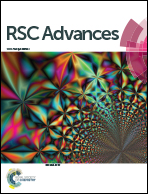PEDOT-PSS coated sulfur/carbon composite on porous carbon papers for high sulfur loading lithium–sulfur batteries
Abstract
Increasing the sulfur loading in the cathode of a lithium–sulfur battery is an important way to improve its capacity for practical applications. To achieve this, the present work proposes using PEDOT-PSS to encapsulate sulfur/carbon black (S/BP) by a facile solution mixing method and the formed composite is then coated on a porous carbon paper. It is believed that the formation of a core/shell structure in the PEDOT@S/BP composite can promote the electron transport and effectively impede the diffusion of polysulfides, and the porous carbon paper is able to retain the electrolyte containing the dissolved polysulfides in the cathode and alleviate the adverse effect of sulfur volumetric expansion. Due to such advantages, the proposed cathode, with a high sulfur loading of 3 mg cm−2, can yield a high reversible capacity of 1041 mA h g−1 and an excellent cycle stability with a capacity retention of 868 mA h g−1 after 100 cycles and an average coulombic efficiency of 99.4%.


 Please wait while we load your content...
Please wait while we load your content...